The Birdman of the Tower of London and the missing ravens
Legend has it that if all the ravens leave the Tower, the kingdom of Britain will fall. Last week there were only eight ravens left, this week just seven remain. Ravenmaster Chris Skaife speaks to Harriet Marsden

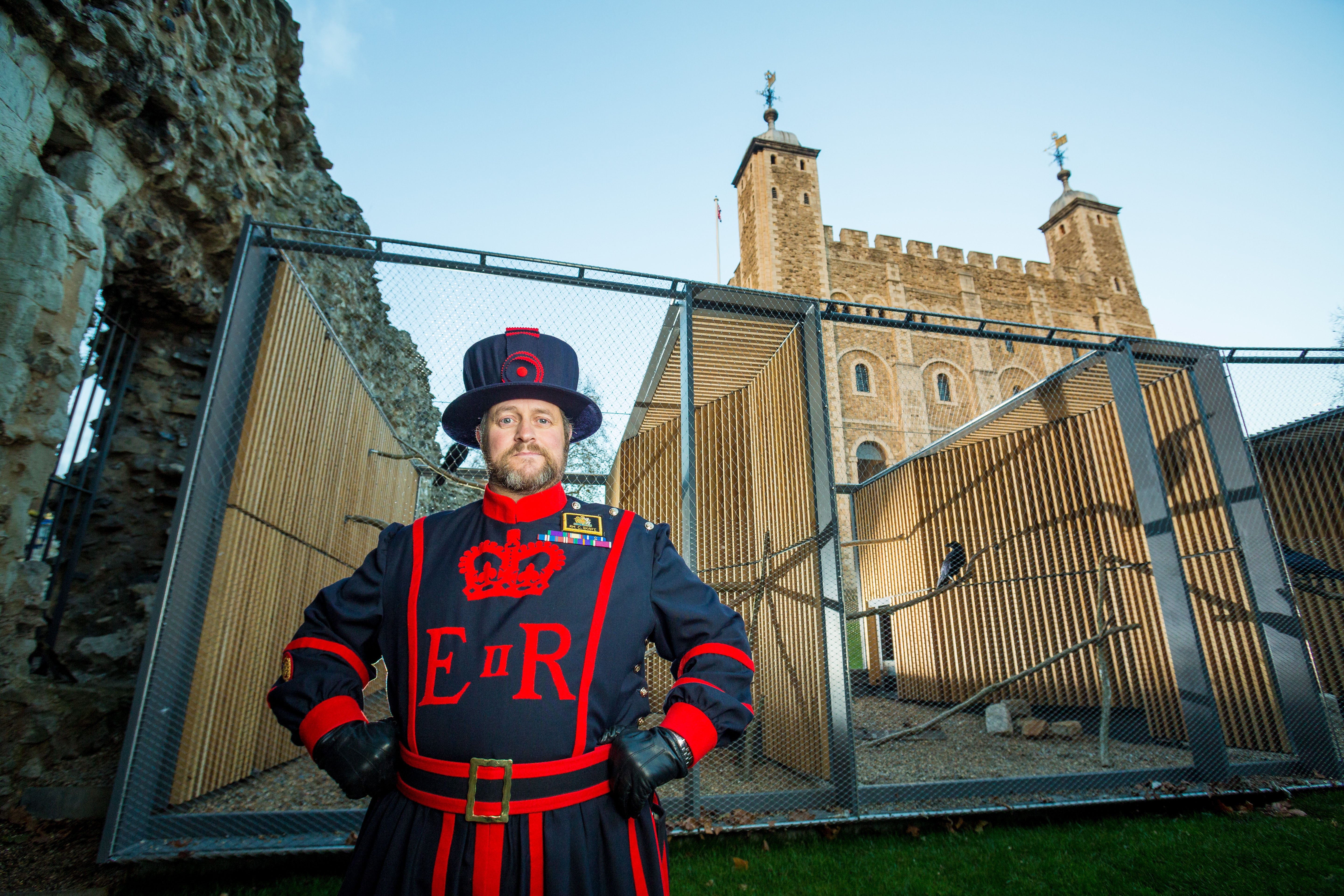
Nothing in Edgar Allan Poe’s majestic poem The Raven prepares you for their smell. But Christopher James Skaife, Yeoman Warder and Ravenmaster of the Tower of London, knows it only too well. “Ravens are quite smelly, especially babies, it’s quite pungent, and I only have a small house tucked into the walls of the Tower of London … the ravens like to walk around our house, and they poo everywhere. That was the first thing my wife moaned about.”
Skaife, now 55, has the often described “oddest job in Britain”: he is responsible for the flock – or unkindness – of ravens who call the Tower home. Legend has it that if all the ravens leave the Tower, the kingdom of Britain will fall. These stately guardians – or his naughty children, as Skaife thinks of them – live on the South Lawn and roam the precincts. And Skaife, the sixth Ravenmaster in the Tower’s history, cares for them.
There must always be at least six ravens, so the legend goes. Last week there were eight. Now, only seven.
Last week, to an outpouring of grief on social media, news broke that Skaife’s closest companion and social media star Merlina was missing. A spokesman for the Historic Royal Palaces (HRP) said: “Our much-loved raven Merlina has not been seen at the Tower for several weeks, and her continued absence indicates to us that she may have sadly passed away.”
Tower ravens are not captives: their wings are lightly trimmed, not clipped, and they are only enclosed at night. A few have left in the past, to return nevermore, but Merlina was different. She and Skaife were partners, bonded. Videos of them playing had become a recent TikTok sensation. But after she’d been missing for a few weeks, the Tower decided to make the announcement.
At the time of her disappearance, Merlina was in “full flight” – her feathers had not been trimmed for several years, so she was free to come and go. “I was hoping that she would stay in and around the precincts of the Tower, because she wanted to stay there, because she was my partner. And I think I did a good job on that, because she did, for so long.”
“I really don’t know why she’s disappeared now, and it’s very strange. I've found no trace of her whatsoever.”
Now, a mysterious world of raven-keepers and legends is headline news – but at its core is a man devoted to his birds. Skaife tells The Independent: “Over the years we formed a bond between us... that was incredibly intimate. I kind of felt her moods and I think sometimes she felt mine, too.
“Of course, I love all the ravens, but she was slightly different.”
When Merlina first joined the Tower, just a little before Skaife in 2007, she was known as Merlin. The baby raven had been found by the side of the road in Wales, and adopted by a family into an aviary.
“It wasn’t until my tenure as Ravenmaster that I affectionately changed her name to Merlina, because we found out that she was female,” says Skaife. “For some strange reason, throughout history ravens have been given predominantly male names … so I'm trying to equal things up slightly.”
As a hand-reared baby, she “imprinted” on to humans and thought of them as her family. Like many intelligent species of bird, however, she was too difficult for captivity. She was given to a Swan Rescue Centre in Barry – where, Skaife recounts in his 2018 autobiography, The Ravenmaster, she became known for her tantrums. Out of desperation, the centre contacted the Tower, and Merlin (as she was known) entered royal service.
You might expect the Ravenmaster to have a background in animal husbandry, or ornithology. Skaife has none of those things. When he first joined the Tower of London as a Yeoman Warder, or Beefeater (ceremonial Tower guard), he had never seen a raven.
Skaife spent most of his teenage years in Dover as a rebel, bunking off school in the woods with his friends. It was only by chance he was even in school the day an Army careers adviser came to speak. Beguiled by stories of goodies and baddies, the 16-year-old Skaife left school to be a soldier. To be exact, a gunner and a drummer.
Any soldier can serve as a Yeoman Warder, but they need at least 22 years of military service, an unblemished record – and perhaps a taste for the macabre. In theory, Yeoman Warders protect the Crown Jewels and any prisoners that might enter the Tower of London. In practice, now, they act as tour guides to the public, storytellers to the children who visit, and keepers of the legends.
When Skaife arrived at the Tower, aged 40, he was “just captivated” by the enormous, yet comical birds. Charles Dickens, famously a raven owner and aficionado himself, described their gait as that of a gentleman with tight boots on, trying to walk fast over loose pebbles. Skafe says: “It’s not until you stand next to a raven that you realise how big and powerful they are. But then I saw these ravens hopping jovially around the Tower… it was their movement, and how they watch the public, that fascinated me.”
Ravens are some of the most intelligent animals in the world, on a par with apes – tool users, forward planners, and perfectly capable of holding a grudge. But Skaife knew “virtually nothing” about the ravens beyond their basic care. His predecessor, Derrick Coyle, had an inkling that the birds might take to him. One day, Coyle shoved him in a raven cage, and told him not to look the birds in the eye.
The ravens – and Coyle – decided that Skaife would do. Coyle took him under his wing as an assistant. In 2011, when Coyle retired, Ravenmaster Rocky Stones took over but not long after he fell ill and Skaife took over almost by default. “It wasn't really until months into the job that I realised that there's a lot more to the ravens than meets the eye.
To be a Ravenmaster, you must learn their rules, the birds’ pecking order. Not unlike the military. The ravens can tolerate no deviation from their routine, and they’re aggressively territorial. A typical day begins at 05:30, when Skaife dresses in the dark to the sounds of early-morning commuter traffic, and hurries out of the Tower to let the birds out for breakfast.
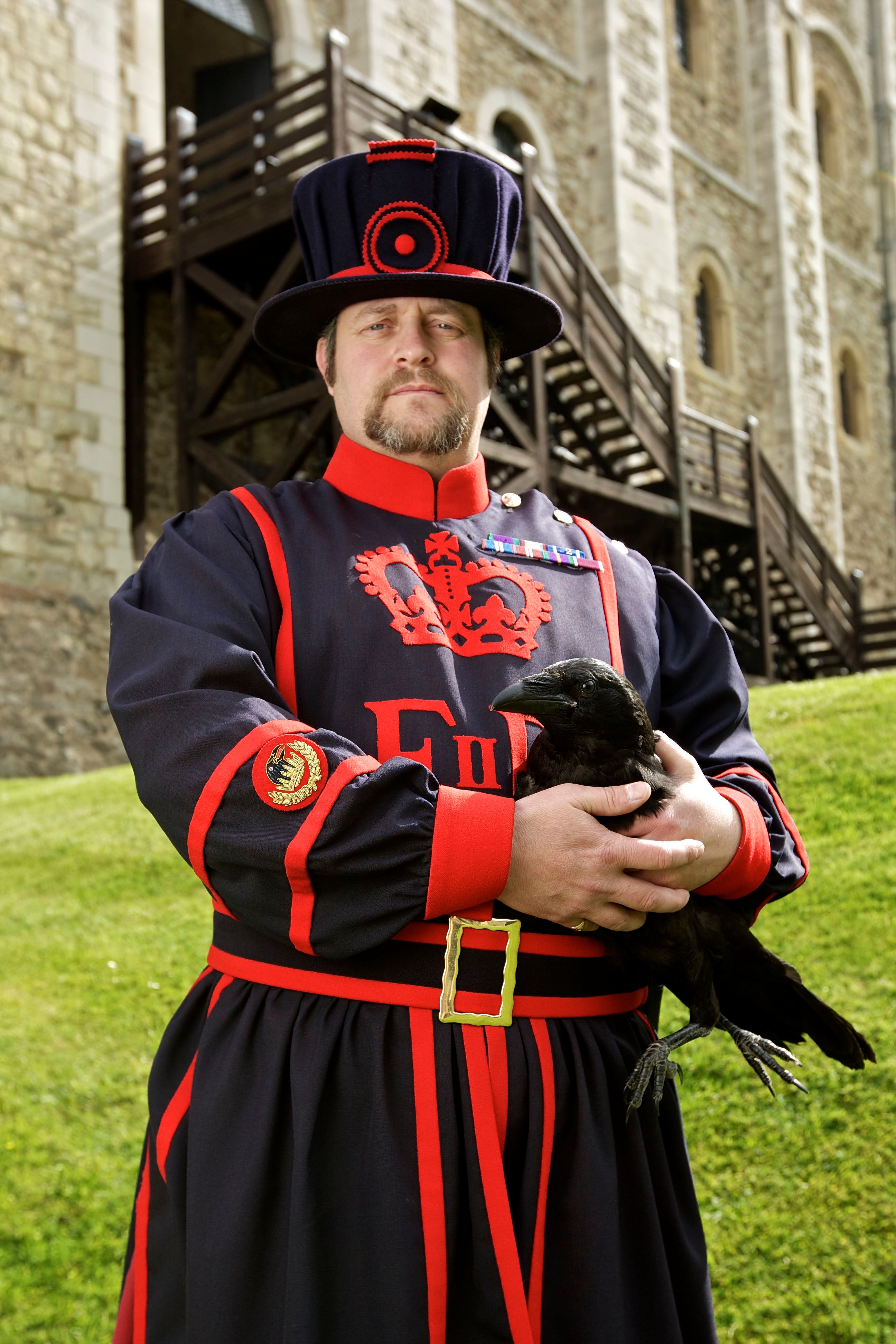
When he first began, the birds were still kept in slightly cramped night boxes from the 1980s. But Skaife says in his book that they “just didn’t feel right” to him. “Ravens are wild birds,” he writes. “Like humans, they need freedom. But they also need protection.”
He approached the staff of the HRP – the charity that looks after the Tower, and other royal sites such as Hampton Court and Kensington – about constructing an enclosure that would allow the birds freedom in the day, and protection at night. After two years of research, and consultation with London Zoo and experts, they came up with the design – although planning permission was no mean feat. And of course, it had to be fox-proof, red pests with whom Skaife is engaged in a “continual battle”.
For the rest of the day, every day, Skaife is keeping his brood in line. He has a team of fellow Beefeaters – the raven team – who assist. They break up fights, feed the birds, dole out medication, and help visiting scientists with behavioural studies. The ravens eat chicken, lamb, rats and as a treat, dog biscuits soaked in blood. A tonne and a half of food a year. Skaife spends a lot of time in Smithfield market, sweet-talking the traders.
The birds became feared, hated as pests and carriers of disease, seen as harbingers of death. An unkindness of ravens, a murder of crows
Like the other Yeomen, he also gives Tower tours, dealing with journalists, historians and children. Skaife is both an educator and a storyteller. He is also an icon: he reckons he is photographed 300-400 times a day. And in fact, the birds are imprinted on him too. He has several raven tattoos – one is of a raven wearing a bowling hat, smoking a pipe.
Skaife researches ravens and writes extensively, children’s stories especially. But he never planned to write The Ravenmaster. “I was asked to do it by an American publishing house, which was very nice of them to want to listen to me waffle all day long.”
Skaife allows the ravens more freedom than any Ravenmaster before. It’s an endless balancing act, he says, letting them roam free while encouraging them to stay. He trims the feathers as little as possible. Merlina, especially, got a free pass. She was the only raven that refused to enter the enclosures, preferring to spend the night on the rooftops. First thing every morning, Skaife scoured the skyline for her silhouette.
But the rest of them get rounded up at night, one by one – in the right order – and sent to their enclosures. Get it wrong at your peril. (In 2010, Raven Munin took advantage of a routine disruption to stage a Great Escape.) And like children, they are often reluctant to go to bed. “I do look at those young warders and think to myself, would they have the patience to be stood out in the pouring rain trying to get a raven off a roof for five hours?” Skaife has had to climb the White Tower to grab an unruly bird, and misses dinner dates galore.
Picture Ravenmaster Skaife, in his stately Blue Undress uniform with royal insignia, chasing a three-kilo bird around the green with a fishing net. He says he’s only had to use it once in 16 years, when a raven’s foot was caught. “The reason I don't use it is because I look like the childcatcher out of Chitty Chitty Bang Bang.”
How does Skaife’s wife feel about Merlina, the other woman? “Well, she saw the film The Birds by Alfred Hitchcock when she was young, and she's never ever forgotten it. So my wife and birds don't get on very well,” he laughs. “She loves what I do and she supports me 100 per cent … but she's not overly fond of birds per se.”
He remembers that when he was raising the chicks, his wife had her toenails painted red. “Poppy had a fascination for these red toenails. So now when the visitors come in, Poppy still thinks the visitors have red toenails and so has been seen biting people's shoes and feet. Be careful when you come around the raven enclosure because Poppy still has a bit of a foot fetish.”
THE LEGEND OF THE RAVEN
The ravens are an emblem of the Tower – the big tourist draw, the feathered Crown jewels. But human fascination long predates London’s famous fortress.
The most widely distributed of all the corvid family (which includes crows, magpies and rooks), ravens can be found in every continent except Antarctica. They also pop up as spiritual figures in indigenous stories all over the globe, from Siberia to Bhutan, to Native American folklore. Norse mythology stars a pair of ravens named Huginn (“thought”) and Muninn (“memory / mind”), who fly around the world and deliver news to the gods. The Icelandic still revere them. According to the Bible, a raven was the first animal released from Noah’s ark.
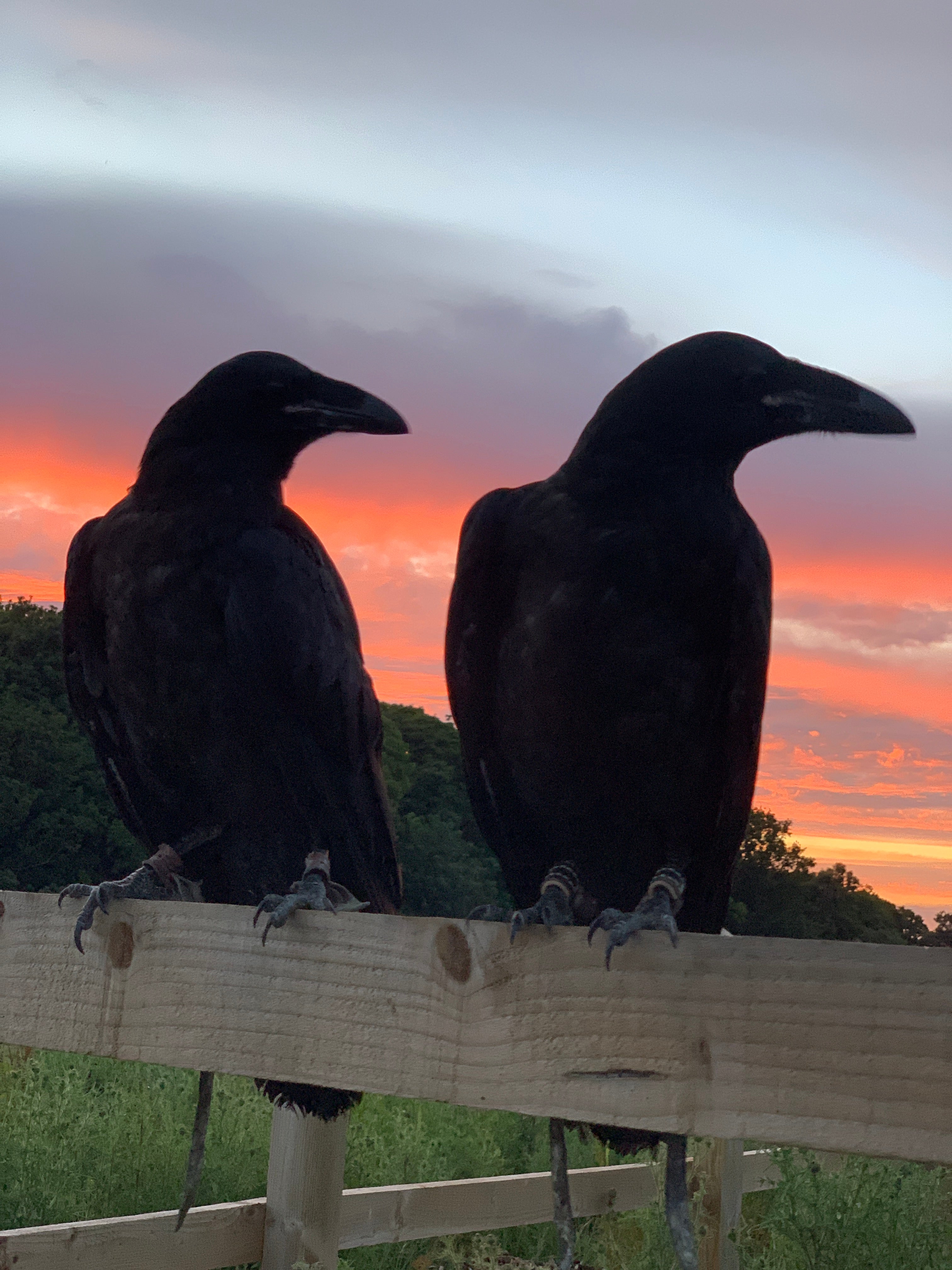
They are prevalent in Celtic stories, too. Welsh legend has it that the head of Bran the Blessed was buried near Tower hill. (Bran means raven.) The bird still appears on the Isle of Man’s coat of arms. In the 17th century, King Charles II is thought to have been the first monarch to insist on the black bodyguards at the Tower. Ravens were abundant in the UK until the 18th and 19th century, when the persecution began.
The birds became feared, hated as pests and carriers of disease, seen as harbingers of death. An unkindness of ravens, a murder of crows. As Poe wrote: “What this grim, ungainly, ghastly, gaunt, and ominous bird of yore?” (Ironically, Poe’s poem, inspired by Charles Dickens and his pet raven, Grip, coincided with a major Gothic revivalism and sparked a new fashion for the birds.) But by the end of the 19th century, they were all but wiped out in the wild.
Their living quarters didn’t help their reputation. The Tower was already synonymous with death, torture and punishment. No less than three queens of England were killed there: Anne Boleyn, Katherine Howard and Lady Jane Grey. The dark grey stone looks ominous in the fading day, and a great deal of blood stains the grass.
As Skaife says: “By nature humans are quite morbid, so we always look for the bad. We do have a fascination for the macabre.” To that end, he believes that some of the older Yeoman Warders were responsible for spinning the more elaborate details of torture; bear in mind, only a handful of people were ever executed at the Tower, and very few were actually tortured under the royal sanctions.
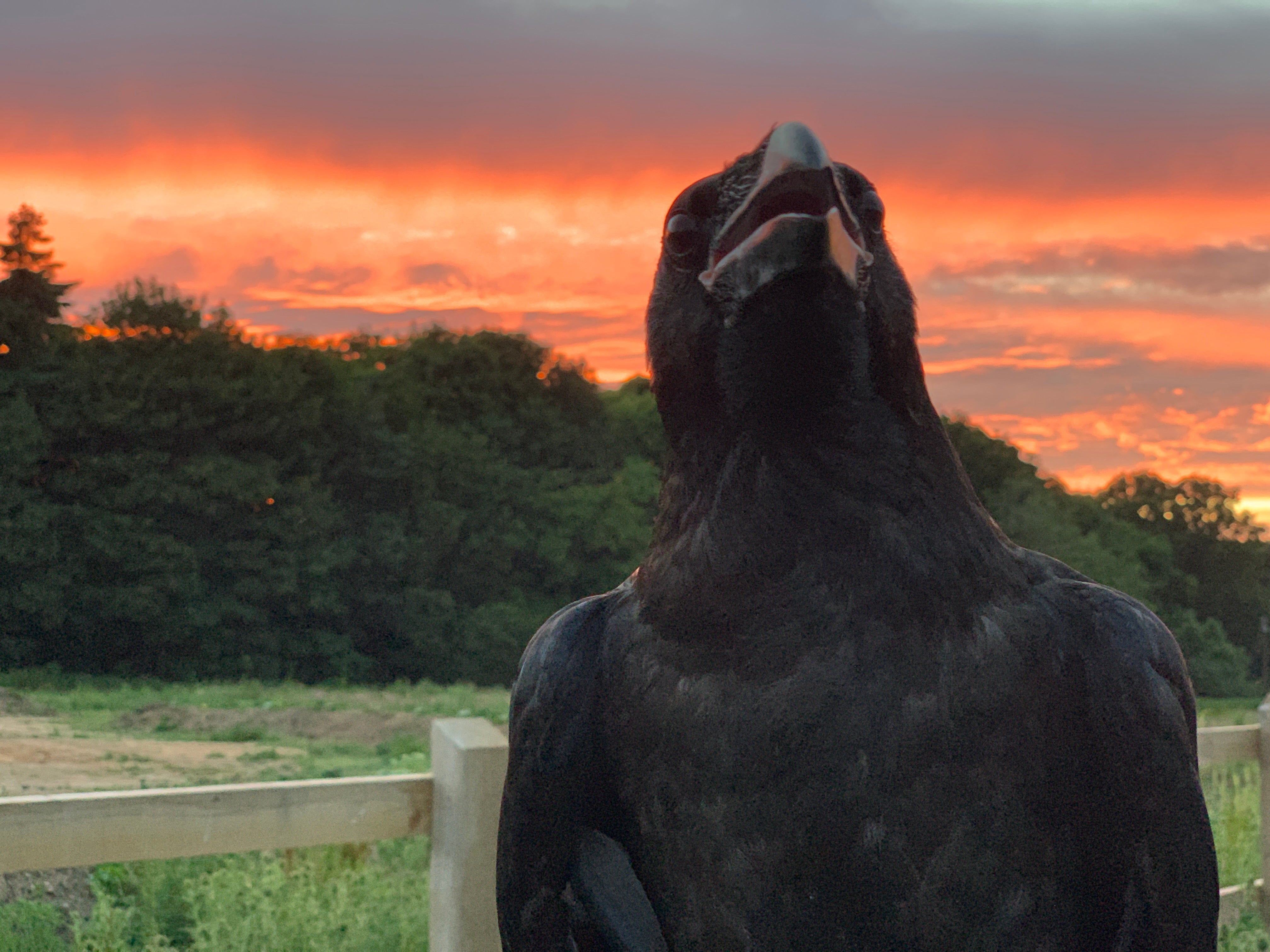
The legend of the Tower ravens, and how their disappearance might signal the end of the Empire, didn’t really appear until the end of the 19th century. Skaife thinks it’s probably quite a modern story made up by Yeoman Warders “to increase a bit of pocket money for themselves”.
During the Blitz, the birds served their country as plane spotters. Sadly, after the bombing had ended, only two ravens survived. The first official Ravenmaster was appointed in 1969, but it was only in 1981 that the country began to protect them under the Wildlife and Countryside Act. And still, despite their high intelligence, corvids – especially crows – are shot in their hundreds.
Dr Nicola Clayton, a professor of animal cognition at Cambridge and a world expert in corvids, says that the species suffers from bad press. “It's claimed that corvids kill some birds’ nests and do all sorts of damage – no they don't. Or that they're responsible for the decline of songbirds – no they're not. The culprits are cats that are allowed outside, and homo sapiens.”
Interestingly, she adds the more black the corvids are, the worse they’re seen. People dislike crows and magpies more than jays, for example, perhaps “because we like pretty colours”. It could also be a superstition, she says, like black cats.
Nowadays, ravens are still extremely rare. In fact, the Tower of London is probably the only place you’ll see them. Clayton actually knows the Tower ravens, and Skaife, well. She adds, by way of eulogy: “My impression was that Merlina adored Chris and Chris adored her, and that she definitely pulled the wingstrings.”
REHABILITATION OF THE RAVEN
Like in Victorian times, the raven is having something of a comeback. When George RR Martin first began to write his series, A Song of Ice and Fire, he visited the Tower – and Skaife – often.
Martin wrote the ravens into his world as messengers, with an omnipotent, all-seeing sage called the Three-Eyed Crow whom young Bran Stark must eventually become. In the TV adaptation, this was changed to the three-eyed raven.
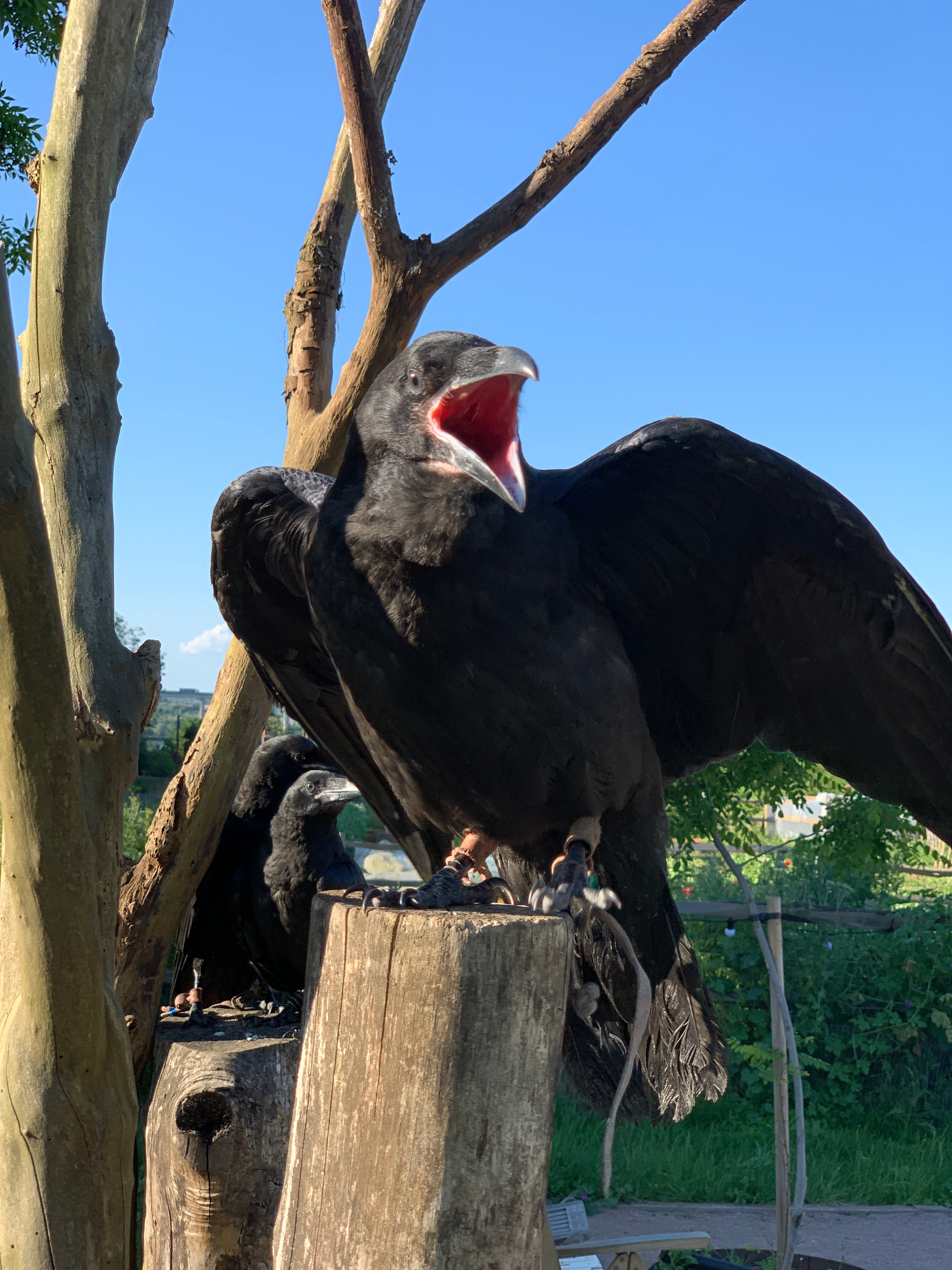
“Martin has done really well for ravens,” says Skaife. “Everybody else writes about them with dark connotations, death and destruction, whereas George did something different. He said to me that he wanted to see the ravens in a more positive light. I’m a great Game of Thrones fan now.”
It’s that juxtaposition of Gothic and comic that makes ravens so captivating: they’re paradoxical. Skaife says the whole flock has a naughty streak. “It’s like walking into a toy shop and having five or six children that you hope will walk beside you, but they just want to go around the aisles and touch all the toys. They can be stroppy but they can be really really affectionate too.”
Which might explain why they have become so popular on social media. In fact, it takes up all of the Ravenmaster’s spare time. He only began posting videos on TikTok a month ago, but already it’s driving a huge audience. “I try to capture as much as I can of the raven doing silly things, they do fall off their perches and bump into things, they do everything that humans do and it's so funny to watch them.
“I've put a few videos up of me stroking Merlina and some others as well … You can see that she's asking me to stroke her and she wanted me to show her that affection.
I try to capture as much as I can of the raven doing silly things, they do fall off their perches and bump into things
“They have that ability to be able to connect. They have feelings like we do – they might not be as fantastic at showing them, but they still have that emotional power to do that, which is incredible.”
Merlina is the star, with a dedicated following on Instagram and Twitter, too. She receives cards from all over the world, has appeared on television, plays with sticks, rolls over. She especially loves prawn cocktail crisps. She was very photogenic, Skaife says, “and I think she just grabbed people’s heartstrings.”
By the nature of ravens, Skaife says, they do attract people who are associated with the darker side of life. And there is a darker side to the surge in popularity, too.
Lloyd Buck, a bird specialist and wildlife presenter, says that because of the success of Game of Thrones, many people were attracted to the idea of getting a pet raven. “But actually they are probably the most unsuitable bird to have.” Highly intelligent, yes, but unpredictable, destructive and surprisingly moody.
Buck should know. Now 53, Buck has been working with birds for nearly 30 years and keeping them since he was six. He and his wife Rose help train animals for natural history-based films and sequences, including with David Attenborough. He has his own raven, also named Bran. In fact, he says, Bran is the son of Skaife’s breeding pair in the Tower.
“With all the corvid species,” Buck says, “there’s that little bit more, something slightly different. I’ve kept birds my whole life, and I’ve never kept another bird like them. When they look at you they really are working you out.”
Like Merlina, Bran was hand-reared – Buck got him when he was just 20 days old, a “baby ball of fluff” – and has imprinted on Buck. Buck says Bran is sweet-natured; a lover of blackberry picking, highly sensitive to Buck’s moods. To Buck’s knowledge, he is the first and only raven who has ever worn a camera, on a little harness. He is probably also the first raven to survive accidentally getting shot in the chest.
Buck says that he has been approached many times by people with baby ravens. He always advises against keeping the bird. Buck, for his part, believes that Merlina is out there somewhere. “Sometimes they just fancy a change. I think there's a good chance that she's alive.”
Mike Keen, another member of the raven-keeping brethren, echoes Buck’s disquiet about the new bird craze. Because they are so intelligent, he says, it isn’t fair to keep them in an aviary. They bore easily, and they can live up to 40 years in captivity: “It’s not like a hamster.”
There couldn’t be a better guy (than Skaife) to look after the ravens. He’s amazing. But trying to keep them at the Tower and not having them fly off is always going to be tricky
But when the 51-year-old Suffolk pub landlord was offered a raven chick by a friend, he didn’t hesitate. “She was three weeks old when I got her, so I had her for about four or five weeks with me as I was outside ... Then I started posting pictures and videos on my Instagram and got involved with the shady underground world of raven-keeping.”
In fact, that’s how Keen met the Ravenmaster: over Instagram. Skaife travelled up to visit The Boot pub, and was impressed with how tame the raven had become, flying free but coming back. “He wanted to build that kind of loyalty into the Tower ravens so they wouldn’t fly away. So we started working on it together.”
In 2018, the Tower launched a raven breeding programme, as it was becoming more difficult to source chicks. (There are relatively few legal breeders.) The following year, Skaife’s breeding pair hatched four chicks – the first babies in the Tower for 30 years. Keen took in three of them, while Skaife kept George – who turned out to be a girl, Georgina. And Keen cared for three baby Tower ravens, in a bedroom pen.
As far as Keen is concerned: “There couldn’t be a better guy {than Skaife} to look after the ravens. He’s amazing. But trying to keep them at the Tower and not having them fly off is always going to be tricky. They’d always be interested in heading off on their own. That's just going to be part of the life of having ravens.”
But, he says, “social media only shows the good bits. I had quite a few people ask me where they could get a raven chick, and to pretty much all of them I said, I wouldn't do it. Luckily they're still pretty hard to get hold of, and they're a protected bird in England. Hopefully it will stay that way.”
It’s a very small world, he says, raven-keeping, “and being quirky is part and parcel of it, because it’s so full on".
THE FUTURE OF RAVENS
The timing of Merlina’s disappearance, in the bleak midwinter of a pandemic and the post-Brexit Union as shaky as it’s ever been, has spooked the public. “We are a superstitious nation,” says Skaife. But, he says: “We still have seven ravens, and they've all got to leave. And then I’d be out of a job.”
He describes the birds like “a group of children who love to play”, each with characters and coloured anklets to tell them apart. Not that Skaife needs the anklets. “Erin’s my oldest, she’s the mother goose, she just bullies everyone. Rocky has a macho name but he’s not macho at all. Harris and Gripp are my adolescents. Little Poppy, she’s beautiful, she’s doing really well but she’s really naughty. Georgie is coming along, learning a lot from Poppy. Jubilee is a bit more majestic.”
That his favourite charge, Merlina, is missing, presumed dead, is heartbreaking, but we can also wish that she’s decided to explore the world now we’re a less prominent feature
So the future of the Empire is safe, for now. But what of the Tower – and the ravens that call it home? As a charitable organisation, the HRP relies on visitors. The profits help maintain the buildings – and feed the birds. The ravens cost less than £10,000 per year to care for, and “more than earn their keep” with tourist interest and of course, the copyright of Skaife’s book. But the pandemic has had a devastating impact on the charity. The spokesperson tells me that they are facing a £100 million shortfall in finances this year – an income reduction of more than 85 per cent.
Last summer, many papers reported that the ravens were growing bored at the drop in tourists, causing them to fly further away. But Skaife is quick to correct them. “What was reported in the papers at the time was not factually correct ... Obviously with the lockdown the ravens had been on their own for a long period of time but ravens are not really the best friend of humans. They love to associate themselves with humans but it's really for one reason and one reason only, and that’s food … The ravens never got bored at all.”
Was the media anthropomorphising the birds, projecting their own frustration on to the flock? Skaife thinks it was more a misunderstanding. They were simply stretching their legs into other territory.
And the ravens weren’t alone, either. What surprises people, Skaife says, is the fact that there's about 150 people living inside the walls of the Tower. “We have our own pub here, we have a chaplain, a constable, our own doctor on site.”
Tourists walking the battlements are often surprised to look down and see cars, washing hanging on lines, and children playing. “It’s a small community in the heart of London.” And the ravens are a part of it.
Like the rest of us, Skaife and his Tower team are on lockdown – Skaife bemoans the poor WiFi around the ancient walls – but they hope to open up the Tower before Easter. Tower staff have no plans to replace Merlina just yet (although, as Skaife says, she is irreplaceable). “Merlina was our undisputed ruler of the roost, Queen of the Tower Ravens,” said the spokesperson. “She will be greatly missed by her fellow ravens, the Ravenmaster, and all of us in the Tower community.”
But, they said, they will hold off on writing her name on the gravestone, just in case she comes back.
For the last four years, Dr Nathan Emery, senior lecturer at Queen Mary’s Hospital and expert in cognitive bird behaviour, has been studying the Tower ravens. (The animal cognition family is small, too. Dr Emery is married to Dr Clayton.) The experiments don’t pay but they contribute a wealth to the study of animal intelligence. Alongside the growing awareness of corvid intelligence is the drive towards conservation. Raven populations are beginning to recover, and the RSPB works hard to bring illegal killers to justice.
But according to Emery, Skaife has “furthered the cause of corvids, and ravens in particular, more than a 100 scientific studies combined could possibly do”.
“His infectious humour and intimate understanding of their nature, through being a member of their flock, is both a testimony to his fascination with them and his ability to care for creatures quite different to us in many ways, but which also possess striking similarities.
“That his favourite charge, Merlina, is missing, presumed dead, is heartbreaking, but we can also wish that she’s decided to explore the world now we’re a less prominent feature.”
Skaife may have served at the tower for 16 years, but he’s only 55. Yeoman Warders can live at the Tower as long as they want, with no retirement age. And he still has a great deal he plans to do with the ravens, like the breeding programme and TikTok education.
Skaife’s daughter, 31, and his wife, no longer live in the Tower bubble with him. They moved out about two years ago to “put down roots” in Whitstable, Kent, where Skaife commutes on his days off. “So I am a bit of a bachelor up here. Just me and seven ravens.”
And as for Merlina, his partner nevermore, Skaife says: “I’m really hoping that she’s out there somewhere, probably gone on holiday or gone to do some charity work or something like that. That's what I hope. Ever the optimist.
“Yes, the loss of a raven is terrible for me, awful for the Tower, but there are a lot of things going on in this world at the moment that puts that into complete insignificance … What’s more important is the fact that she’s given a lot of love to people throughout the years. That’s what I want her to be remembered for.”




Join our commenting forum
Join thought-provoking conversations, follow other Independent readers and see their replies
0Comments